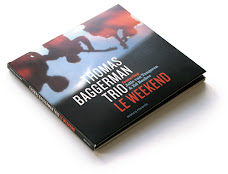So I have been practicing for awhile now, and some problems arise. It's not hard to find Gypsy Jazz lesson resources on the internet, and so I found myself with a great collection of studybooks, DVD's, online Howto's and Guitar Pro files stacked up in front of me and I started to lose track. Where to start?

A selection of my Gypsy Jazz studybooks
According to my teacher Thomas the answer was; Technique!The key to good Gypsy Jazz playing absolutely lies in the technique that differs completely from other guitar styles. First there's the right wrist angle needed to free the top of the guitar and allow it to produce as much sound as possible (the nature of this lies in the fact that Django Reinhardt used to be a banjo player, when he switched to the guitar as a jazz instrument he needed the produce as much volume as possible to be heard in the ensemble since electric guitars were not yet invented.) And then there's the swept picking style that gives all the character to Gypsy Jazz, the pick is used to hammer on the strings a bit like its done inside a piano, this is also for volume purposes. A good control of your right hand or "La Plume" (the feather) as it's called is absolutely unbearable in the genre and a much discussed skill in the Gypsy Jazz scene.
The other important thing to realize are the typical chord shapes en the vertical descent during scales and arpeggios on the guitar neck. A lot of these unique techniques come straight from the fact that Django, due to a fire that burned his caravan, only had two functioning fingers on his left hand. When you look well at Gypsy Jazz fingerings and remenber this fact, it will help you understand how the music works.

Django Reinhardt and his two finger technique
Back to the study material;
Knowing this now, and talking to my teacher about it he recommended two useful resources: Michael Horrowitz's Gypsy Picking and Denis Chang's the art of accompaniment. I myself would add Samy Daussat's Swing Manouche Super Debutant (only available in French) because it has some very easy to play but very characteristic tunes in it.
A tune from Samy Daussat's book.
This is for me the base I use to learn to play Gypsy Jazz. Wrong technique (so I've been told) can take years to be corrected again, and I really would like to avoid this.
So it was back to square one for me, the few months I had been practicing were not all lost but I had to leave my "Minor Swing" solo practice to play open string exercises. This might seem a little boring at first, but after a few weeks sweep picking was almost natural to me. Even when trying to play some easy Nirvana tunes I had practiced when first playing the guitar I found myself doing it in the Gypsy Jazz sweep picking style automaticly.
Others might say that in the real Gypsy Jazz tradition learning to play good rhythm is the first thing you do, and of course good rhythm playing techniques are very important and you should use a great deal of your practice time playing along rhythm sessions to your favourite Django recordings. But I don't see why you shouldn't learn soloing and rhythm at the same time. Important is to get good at both.
Conclusion: I find that good Gypsy Jazz playing starts with good technique, a little like the "wax on, wax of" story in the old karate kid movies; it might seem boring and useless at first, but will payoff loads when you finally get to realy play.
Click to read entire weblog!
See the trailer of the new documentary about Gypsy Jazz I'm making!






